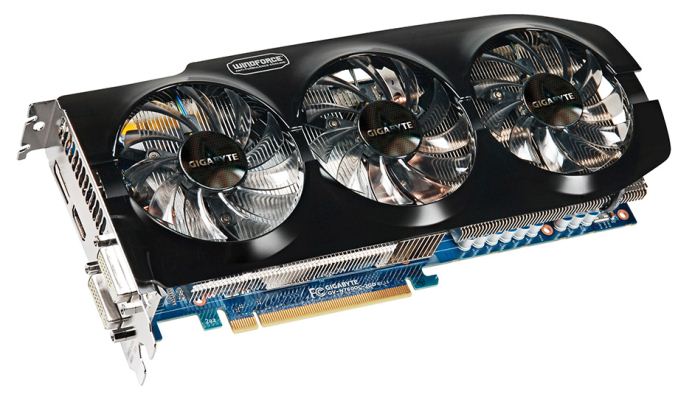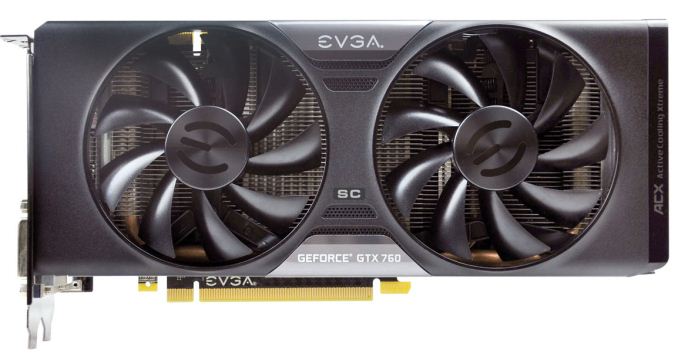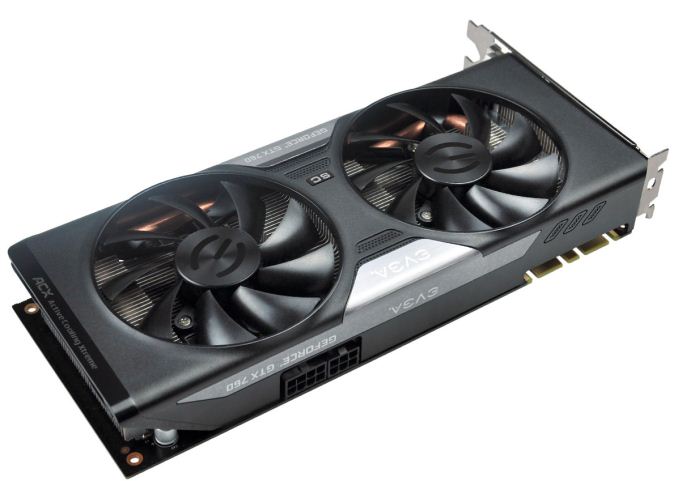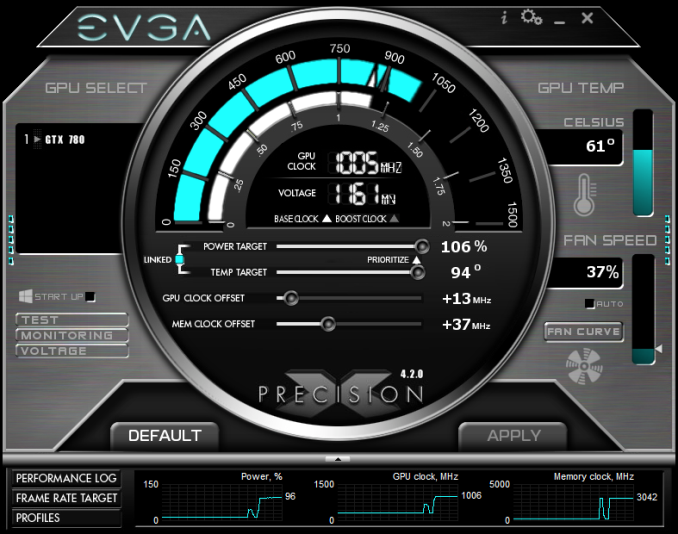
Original Link: https://www.anandtech.com/show/7398/the-geforce-gtx-760-roundup-evga-and-gigabyte-compared
The GeForce GTX 760 Roundup: Gigabyte and EVGA Compared
by Ryan Smith on October 7, 2013 2:00 PM EST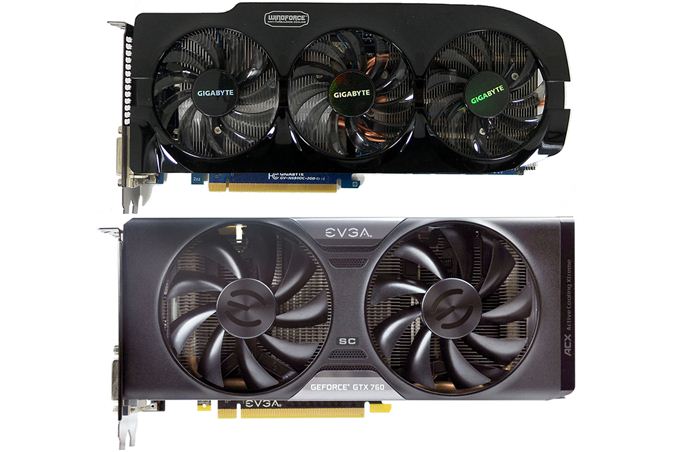
Last week we took a look a selection of semi-custom and custom GTX 770 cards. Based on NVIDIA’s otherwise “small and unassuming” Kepler workhorse GPU, GK104, we found that due to NVIDIA’s pushing GK104 so hard on the stock configuration, there wasn’t quite as much overclocking headroom as usual left in the design. As a result GTX 770 cards end up performing quite similar to each other even with factory overclocks thrown into the mix. This does make it a bit harder for NVIDIA’s partners to stand apart in a crowded field, but ultimately their products could still differentiate themselves based on card/cooler design, warranties, and other value added aspects.
Today we’ll be looking at the opposite end of the spectrum with custom cards based on NVIDIA’s GeForce GTX 760. Still based on GK104, GTX 760 is NVIDIA’s low-end GK104 SKU targeted towards high graphical quality 1080p gaming. Compared to GTX 770 it operates at lower clockspeeds and with fewer SMXes, lower TDPs, and comes in at a much lower MSRP of $250. The lower clockspeeds of GTX 760 mean that partners have a bit more headroom to play with for factory overclocks, but like the GTX 770 that performance needs to be backed up with a solid design and good value added functionality if it’s to start apart in what’s an equally crowded market.
Today we’ll be looking two such cards, once again coming from EVGA and Gigabyte. Both are fully custom cards pairing factory overclocks with custom coolers and custom software, so both vendors come into this on relatively equal footing.
| GeForce GTX 760 Specification Comparison | |||||
| GeForce GTX 760 (Ref) | EVGA GTX 760 Superclocked ACX | Gigabyte GTX 760 OC Windforce 3X | |||
| Base Clock | 980MHz | 1072MHz | 1085MHz | ||
| Boost Clock | 1033MHz | 1137MHz | 1150MHz | ||
| Memory Clock | 6GHz | 6GHz | 6GHz | ||
| VRAM | 2GB | 2GB | 2GB | ||
| TDP | 170W | >170W | >170W | ||
| Width | Double Slot | Double Slot | Double Slot | ||
| Length | 9.5" | 9.5" | 11" | ||
| Warranty | N/A | 3 Year | 3 Year | ||
| Price | $249 | $249 | $259 | ||
Gigabyte GTX 760 OC Windforce 3X
The first card in today’s roundup is Gigabyte’s GTX 770 OC Windforce 3X. As has become the case for Gigabyte in the past year or so, their factory overclocked cards are focused on bigger and better, typically packing larger coolers and higher factory overclocks than the comparable cards from other vendors, something the 760OC Windforce lives up to in full.
The 760OC Windforce is a fully custom card, pairing a custom Gigabyte PCB with Gigabyte’s high end Windforce 3X cooler. As far as clockspeeds go the 760OC Windforce ships with the larger of the factory overclocks in today’s roundup, shipping at a core clock of 1085MHz, 105MHz (10%) over the stock GTX 760. Surprisingly, the 760OC Windforce does not ship with a memory overclock despite the fact that the stock memory frequency on GTX 760 is only 6GHz, so any performance gains must come solely from the core overclock. With that said factory memory overclocks are exceedingly rare on GTX 760 cards altogether, so Gigabyte is not alone here.
Breaking down the construction of the card, Gigabyte has equipped the 760OC with their traditional Windforce 3X cooler, the largest of the company’s line of Windforce coolers. This is the full size Windforce 3X, measuring at 11 inches long, making it an inch longer than the 10 inch PCB Gigabyte uses for this card. Consequently the card has a definite “oversized” aspect to it due to the heatsink hanging off the rear, though despite the oversized cooler the construction on the card is fairly rugged thanks to a stiffener that runs most of the length of the card. Ultimately this coupled with the solid construction of the heatsink, mechanically supported by the VRM heatsink below, keeps the card from flexing too much in any direction.
As far as Gigabyte’s custom PCB is concerned, the company isn’t doing anything particularly exotic here. But for discrete components the company is once more using their Ultra Durable VGA components, which guarantees the use of solid (ferrite core) chokes, Japanese sourced solid capacitors, and low RDS MOSFETs in the name of improving efficiency and overclocking stability; though with a 230W card, it’s hard to imagine Gigabyte going with anything else in the first place. On a side note, Ultra Durable VGA also guarantees the use of Hynix or Samsung GDDR5 RAM, though the thermal pads have worn out the lettering on the RAM, so we can’t tell which it is from looking at the card.
Moving on we have Gigabyte’s Windforce 3X cooler and “triangle cool” based heatsink. This is Gigabyte’s highest end cooling configuration, and while Gigabyte’s claimed 450W capacity isn’t something that’s testable on this configuration it’s clearly an oversized cooler for the 170W GTX 760. The Windforce 3X cooler has 3 75mm fans pushing air along the card, and in practice results in most of the front surface area of the card being made of fans.
Meanwhile the 760OC Windforce’s heatsink is equally oversized, being composed of two segments that run the full 11 inch length of the card, and implement Gigabyte’s “triangle cool” heatsink technology to reduce fan turbulence. 3 copper heatpipes run between the heatsinks and the GPU for transferring heat, and furthermore a simple aluminum baseplate covers the RAM and other components immediately near the GPU, transferring heat to the heatsink directly above. A small heatsink also covers the MOSFETs that are part of the primary VRMs, both supporting the primary heatsink above against flexing while also providing surface area for cooling for those MOSFETs.
Moving on, like the other cards in this roundup Gigabyte implements NVIDIA’s standard display I/O configuration of 2x DL-DVI, 1x HDMI, and 1x DisplayPort 1.2. Meanwhile Gigabyte has gone above and beyond on power delivery, using 6pin + 8pin external PCIe power connectors that will be able to provide the card with far more than the 170W it officially requires at stock.
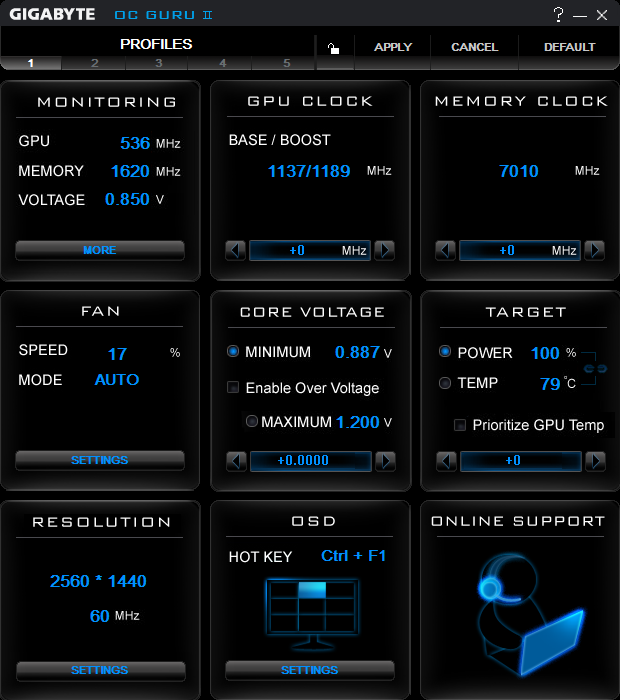
Gigabyte rounds out their package with their OC Guru II overclocking and monitoring software. As far as overclocking software goes, OC Guru II is not going to be the gold standard for software due to some of the clunky interface choices Gigabyte has made – mainly a lack of sliders – but it is competent at its task. OC Guru II offers the full suite of monitoring and overclocking controls we’ve come to expect, including the ability to overvolt (unlock restricted boost bins) on GTX 760.
Finally, as with all of Gigabyte’s North American cards, the 760OC Windforce comes with Gigabyte’s standard 3 year warranty. For pricing Gigabyte is charging a slight premium here, with the MSRP on the 760OC currently landing at $259, $10 over the MSRP for a stock GTX 760. Gigabyte does offer a non-overclocked variant of this card, so the $10 primarily covers the 10% factory overclock.
EVGA GeForce GTX 760 Superclocked ACX
Our other card for this roundup is EVGA’s GTX 760 Superclocked ACX. This card is a fully custom card, utilizing a custom EVGA PCB in conjunction with EVGA’s recently launched ACX cooler. All of this is then wrapped up with a moderate factory overclock that sees EVGA ship the card at 1072MHz core, 65MHz (9%) over the GTX 760 reference clockspeeds.
Like the 780SC ACX and 770SC ACX cards we’ve looked at previously, the 760SC ACX marks the first time we’ve seen EVGA’s new ACX cooler in this category of product. The ACX cooler is a notable departure from the norm for EVGA, who previously did not seriously involve themselves in the branded custom cooler market. With the ACX cooler EVGA is not only looking to tap into that market, alongside the larger market for open air coolers, but the company is looking to make a name for themselves based on build quality of their cooler, something EVGA’s competitors don’t always invest as heavily in and/or call as much attention to.
At its most basic level, the ACX cooler is a typical dual fan open air cooler, as we’ve seen countless times from other manufacturers. This basic design is very effective in moving large amounts of heat for relatively little noise, making the usual tradeoff of moving some of the cooling workload onto the system’s chassis (and its larger, slower fans) rather than doing the work entirely on its own. In EVGA’s case they’re using larger than typical fans for a dual fan cooler, with the ACX cooler’s fans coming in at 90mm diameter.
Meanwhile everyone has their own slight variations in design here, with EVGA focusing on running a full length heatsink to maximize their heatsink surface area. The heatsink itself is single segment heatsink with 3 large copper heatpipes from the center of the heatsink and the GPU around to each end of the heatsink. An aluminum baseplate is present on the card, but it only covers the rear half of the PCB which is sparse on components. The MOSFETs and other power delivery components are located near the front of the card, with cooling provided by the primary heatsink itself.
As for EVGA’s quality angle, the company is paying specific attention to the fans on their ACX cooler, using a fan blade design they say is optimized for strength and weight, while driving those fans with a double ball bearing motor. Much like the basic double fan design, ball bearings aren’t a major innovation in this space, but they are inconsistently used, often going unmentioned or interchanged with traditional sleeve bearings from one generation to the next. Mechanically speaking, compared to sleeve bearings, ball bearings typically have greater longevity and a bit less noise under heavy load, in exchange for a bit more noise at idle, making them a good tradeoff for a high-end card. From a practical point of view the longer lifespan of ball bearings will be the greatest gain out of this, while any noise tradeoffs are secondary as the fan itself will usually be the greater factor.
Cooling and factory overclock aside, the 760SC ACX is otherwise typical for a retail GTX 760 card. At 9.5 inches long for both the PCB and heatsink, this is the shorter of the two cards we’re looking at today, and marks the first time we’ve seen the more compact version of the ACX cooler; EVGA’s other cards were an inch longer. I/O is also standard with NVIDIA’s display I/O configuration of 2x DL-DVI, 1x HDMI, and 1x DisplayPort 1.2. Like Gigabyte, EVGA is over-delivering on power in their design; the 6pin + 8pin external PCIe power connectors will have no trouble delivering enough power for this card.
Rounding out the package is EVGA’s usual collection of software and hardware accessories, including a pair of PCIe power adapters and a DVI to VGA adapter. As far as EVGA’s software goes there’s little to be said that we haven’t said before: EVGA still shares the gold standard for software, with their fantastic Precision X overclocking utility and their OC Scanner X artifact scanning utility. Despite being based on the same RivaTuner core as MSI’s Afterburner, Precision X has diverged from Afterburner a bit over time, but as far as base overclocking and monitoring functions are concerned Precision X is among the best. And EVGA’s OC Scanner X software is second to none.
Meanwhile, as with all of EVGA’s North American cards, the 760SC ACX comes with EVGA’s standard 3 year transferable warranty, with individual 2 or 7 year extensions available for purchase upon registration, which will also unlock access to EVGA’s step-up upgrade program. Finally, the MSRP on the card is $259, $10 above the MSRP for the standard GTX 760. However with a $10 mail in rebate active as of the time this was written, it brings the card down to $249, the MSRP of the stock GTX 760 and $10 cheaper than the Gigabyte card. As a result the card is something of a no-brainer within EVGA’s lineup, as it leaves little reason to purchase the non-Superclocked version of their GTX 760 ACX. On a final note, EVGA is also running a Rise of the Triad promotion right now alongside NVIDIA’s Batman: Arkham Origins promotion. So the card comes with a pair of free games instead of just the one.
Gaming Performance
Having taken a look at the specifications and construction of Gigabyte and EVGA cards, let’s dive into the matter of their performance. Note that the stock clockspeeds for these cards are within 13MHz (one boost bin) of each other; this goes for the boost clock and the max boost bin, too. Futhermore memory clocks are tied entirely at 6GHz each.
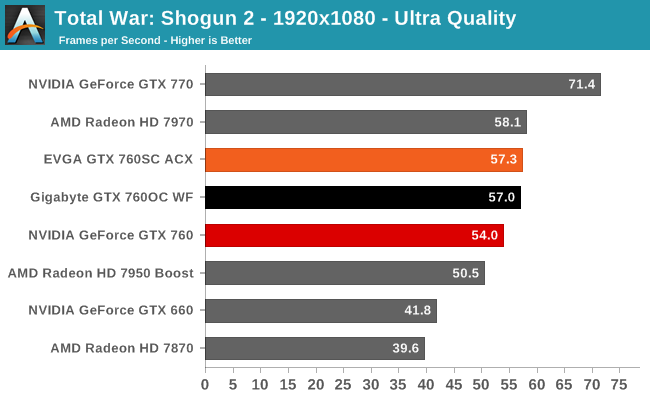
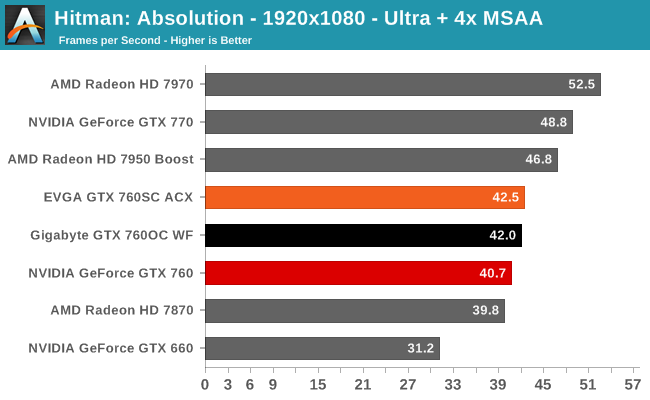
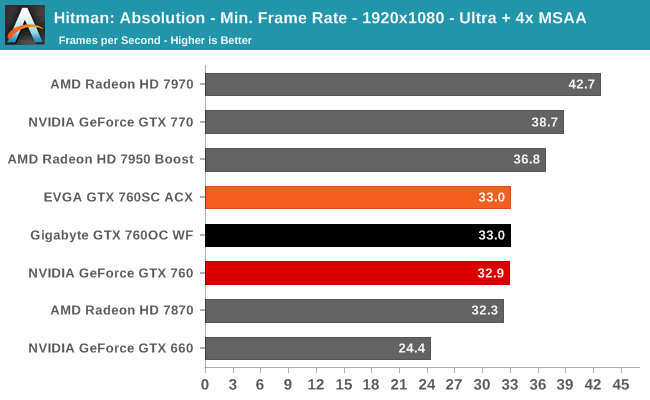
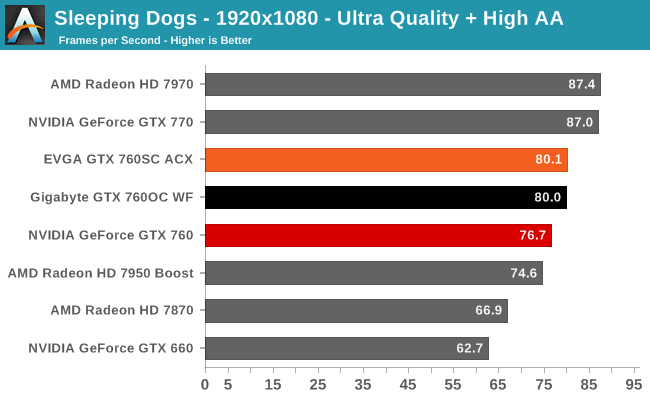
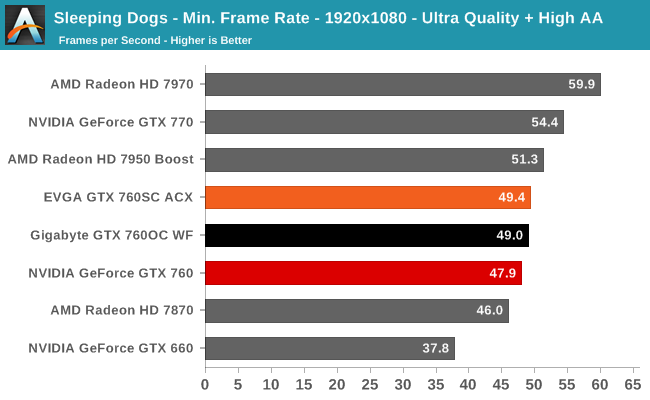
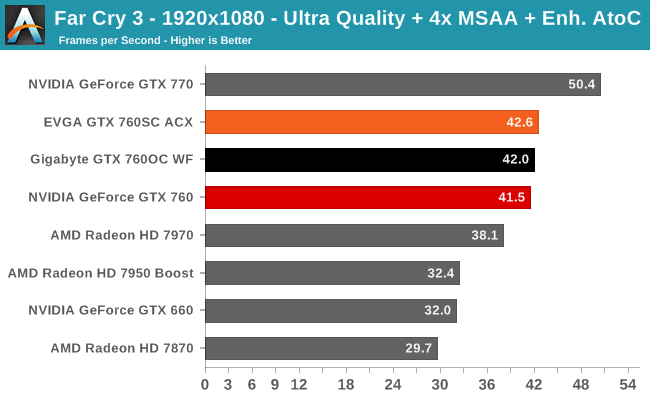
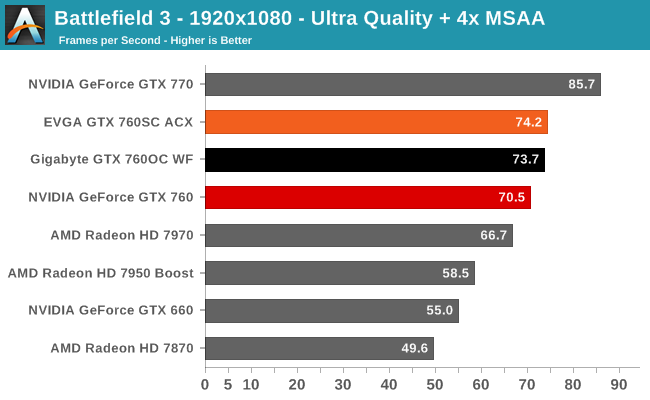
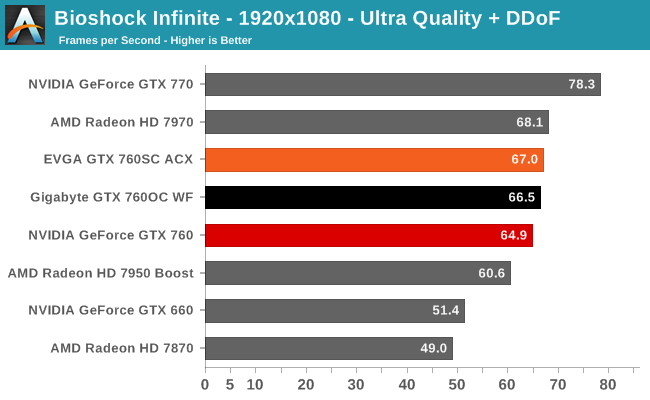
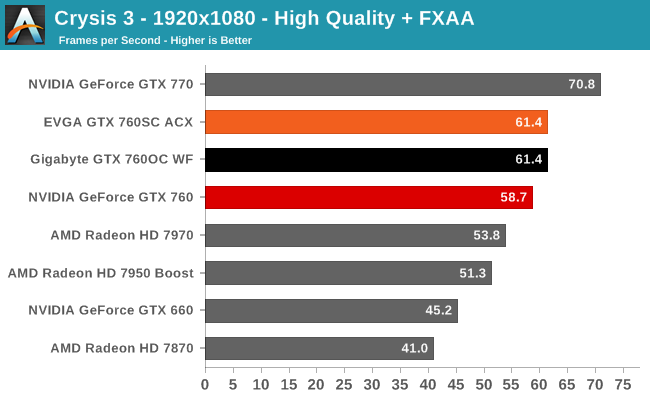
Because the two cards are so close in clockspeeds, there’s little appreciable difference to speak of in our benchmarks. They are for all intents and purposes tied; the margin for experimental variation is larger than the 1% variation in clockspeed between the two cards. That said, the EVGA card does end up technically surpassing the Gigabyte card rather consistently, which is somewhat surprising since it’s the Gigabyte card that has the clockspeed advantage.
Compared to a reference clocked GTX 760, both are notably faster, but not especially so. Without a memory overclock the performance gains are limited to scenarios where the games in question are mostly GPU limited as opposed to memory bandwidth limited, so the gains range between 3% in games such as Bioshock, up to 6% in games like Total War: Shogun 2. On average the cards are just 4% faster than their stock clocked counterpart, less than half the GPU overclock they possess. 4% is not insignificant, but it’s typically not enough to buy higher quality settings or higher resolutions. Factory overclocks really don’t start getting interesting unless we can pass 5%, which both cards are coming up just shy of.
Power, Temperature, & Noise
Having seen the gaming performance of these cards and the limited gains from their factory overclocks, let’s move on to power, temperature, and noise. With their virtually identical clockspeeds and performance, if these cards are going to differentiate themselves it needs to be accomplished by factors the manufacturers have more control over, and their respective coolers are a good way to do it.
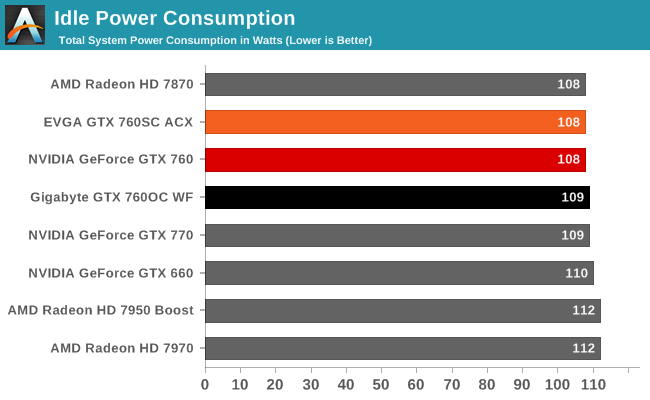
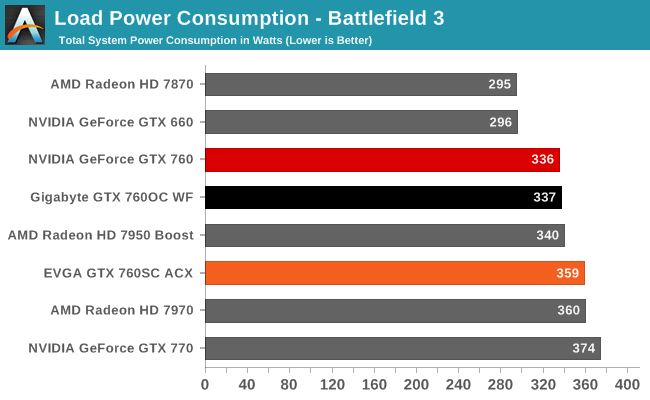
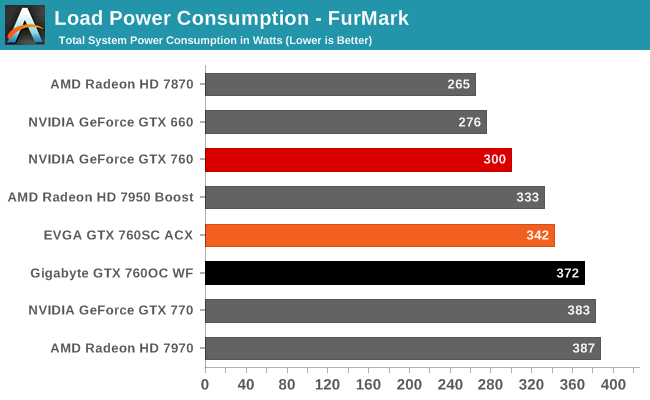
Curiously, power consumption shows a much wider variation than we’d expect. The 22W at-the-wall difference under BF3 is the kind of gap we’d expect for cards of different product lines rather than two cards within the same product line. In this case Gigabyte’s power consumption is practically tied with our reference GTX 760, while the EVGA card is clearly drawing more power, which puts the EVGA card at a disadvantage here. Unfortunately it’s one that will have repercussions for temperatures and acoustics.
FurMark meanwhile flips the picture entirely. Now the Gigabyte 760OC is drawing more power than the EVGA card, on the order of 30W, and a full 72W more than the stock GTX 760. With FurMark being a fairly pure test of TDP and sustained loads, there appears to be two things going on. First and foremost, the significant cooling capacity of the Windforce cooler means that the card never temperature throttles and always reaches its TDP/voltage limits, even under FurMark. Second of all, since this is a recycled Gigabyte design intended for a 225W+ card, it would appear that the power target for this card is higher than 170W as in the card’s official specs.
The EVGA card, though drawing less power than the Gigabyte card, falls into a similar scenario. 42W over our reference GTX 760 at the wall is nothing to sneeze at. It would appear that EVGA’s design is similarly designed for a higher TDP, but lower than Gigabyte’s. Though with both cards being built for higher wattages, there’s also some room for overhead from the use of more complex power delivery systems than what we saw in the reference GTX 760.
Regardless, in these cases we’re more interested in gaming power consumption than FurMark power consumption, seeing as how we don’t expect Gigabyte’s higher power targets to be reached at stock due to the fact that the GTX 760 should run out of headroom in other areas first. As such Gigabyte looks to have a power consumption advantage where it will matter most.
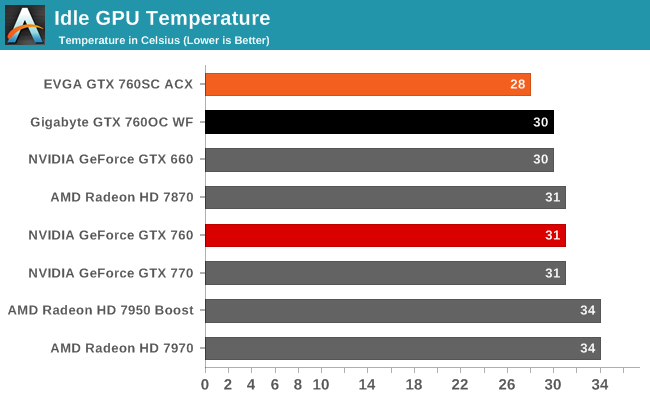
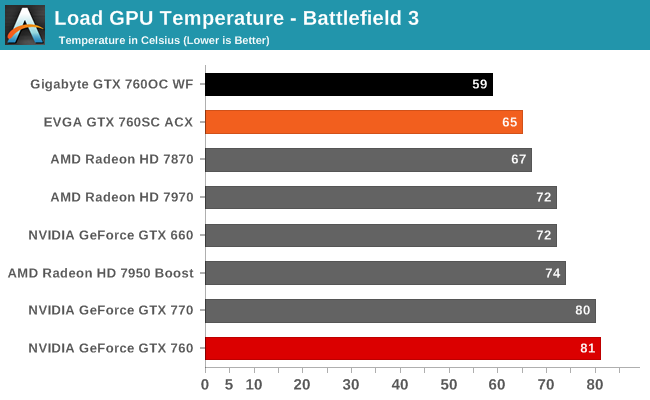
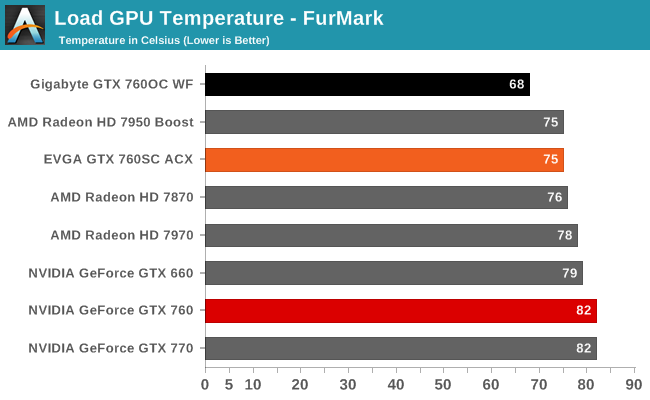
Moving on to temperatures, we’re seeing a clear advantage for Gigabyte’s design here. The 760OC runs 6C cooler under BF3, and 7C cooler under FurMark. These temperatures mean that under FurMark both cards are easily below the 80C throttle point, but it’s still a clear victory for Gigabyte here. EVGA’s higher power consumption here isn’t doing them any favors, but unless there’s a radical difference in the fan curves – and as we’ll see there isn’t – this difference is going to be the result of both the higher power consumption and less effective cooling.
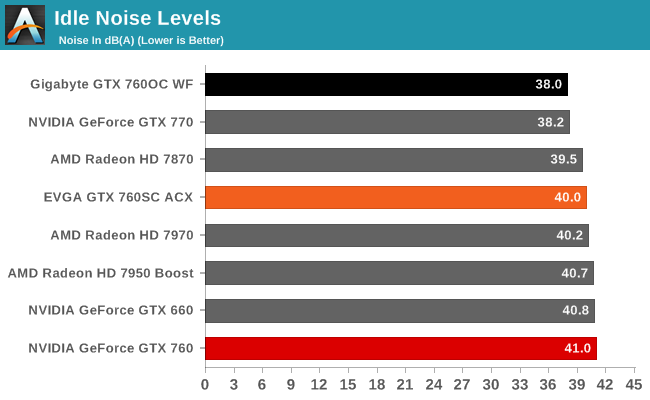
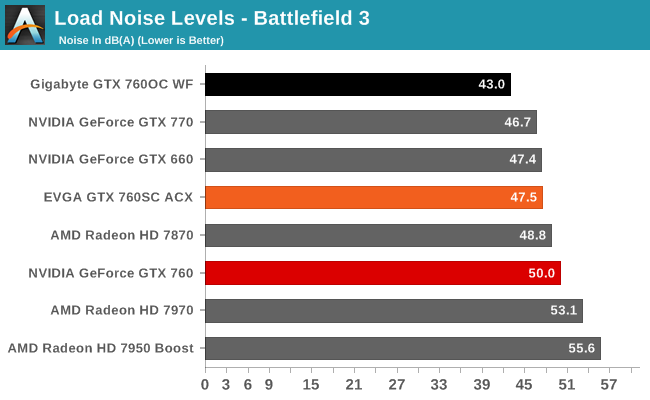
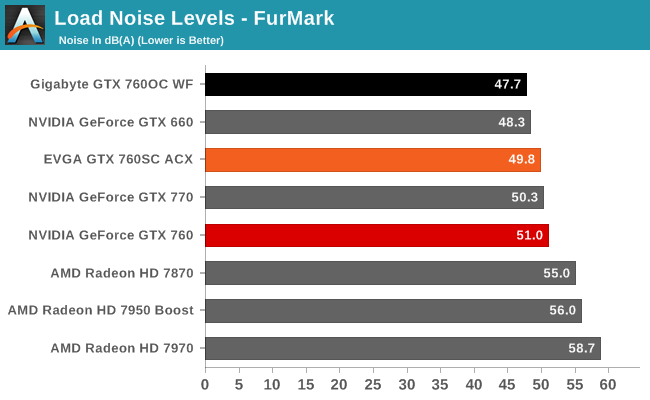
Finally looking at our noise results, we once again are seeing a clear advantage for Gigabyte. Along with being cooler, their 760OC also ends up being quieter than EVGA’s 760SC under both BF3 and FurMark. The difference under BF3 ends up being 4.5dB, and even with Gigabyte’s higher power consumption under FurMark it’s still a 2.2dB advantage. EVGA’s performance is by no means poor for a 170W+ open air cooled card, but as we can see from these results Gigabyte’s 760OC is going to be noticeably quieter under the same workloads. Even idle noise is in Gigabyte’s favor by 2dB.
Ultimately with a sample size of one it’s not possible to isolate every factor, but based on our data we suspect we have a poorer than average GPU on the 760SC ACX from EVGA. The greater power consumption under BF3 and the higher temperatures point to a hotter than average chip while also ruling out fan curve differences as a factor. That said we can’t eliminate the 9.5” ACX cooler from the equation, and indeed that may play a part as well.
As a result of all of this, Gigabyte comes just short of a clean sweep in our power, temp, and noise testing. The only place where EVGA’s card does better is power consumption under load with FurMark, and that’s almost certainly down to power target differences between the two cards. In gaming scenarios power consumption should tread much closer to the BF3 results, and in those scenarios Gigabyte does better.
Overclocking
Last but not least we have our customary look at overclocking performance. With both cards being custom cards, these cards have some notable differences between them. Chief of which in fact is that only the EVGA card can be overvolted to 1.212v. Gigabyte’s card, though having the overvoltage function exposed via NVIDIA’s drivers, doesn’t actually work, leaving the card at 1.2v max at all times. As a result EVGA’s 760SC ACX will get one more boost bin at a higher voltage to play with than Gigabyte’s card will.
Furthermore there is also a difference in power target adjustability that may also play into EVGA’s hands. The 760SC ACX can have its power target raised by 15%, but the 760OC’s can only be raised by 10%. However if our suspicions are right and Gigabyte has a higher default power target in the first place, then the difference should not significantly handicap the Gigabyte card.
| GeForce GTX 760 Overclocking | |||||
| GTX 760 (Ref) | EVGA GTX 760SC ACX | Gigabyte GTX 760 WF | |||
| Shipping Core Clock | 980MHz | 1072MHz | 1085MHz | ||
| Shipping Max Boost Clock | 1149MHz | 1228MHz | 1215MHz | ||
| Shipping Memory Clock | 6GHz | 6GHz | 6GHz | ||
| Shipping Max Boost Voltage | 1.2v | 1.2v | 1.2v | ||
| Overclock Core Clock | 1130MHz | 1130MHz | 1185MHz | ||
| Overclock Max Boost Clock | 1306MHz | 1300MHz | 1306MHz | ||
| Overclock Memory Clock | 6.5GHz | 6.5GHz | 6.8GHz | ||
| Overclock Max Boost Voltage | 1.212v | 1.212v | 1.2v | ||
Starting first with the GPU overclock, it’s interesting to note that we have a wide gap in base clockspeeds attainable, but not in the maximum boost clock each card reaches. As far as base clocks are concerned Gigabyte achieves 1185MHz versus EVGA’s 1130MHz, which is 100Mhz (9%) and 58MHz (5%) over stock respectively. But at the maximum boost clock it’s 1306Mhz for Gigabyte and 1300MHz for EVGA, a difference between the cards of only 6MHz, making it a practical tie. The fact of the matter is that these cards will rarely reach their maximum boost bins and we expect there to still be some kind of a performance difference, but it means they’re going to spend most of their time on equal footing, more so than the base clocks would have us believe.
Meanwhile, like GPU overclocking memory overclocking sees the Gigabyte achieve the better overclock. Here the 760OC tops out at 6.8GHz while the 760SC ACX tops out at 6.5GHz. 6.5GHz is fairly common for a GK104 card, while 6.8GHz would be doing better than average in our experience. We are definitely memory bandwidth limited at times even on the lower performance GTX 760, so the 5% additional memory bandwidth may be useful for Gigabyte. The question going into our testing will be whether Gigabyte’s higher memory overclock and higher base GPU overclock will give them a significant boost, or if TDP restrictions and similar maximum boost clocks will keep the two cards close together.
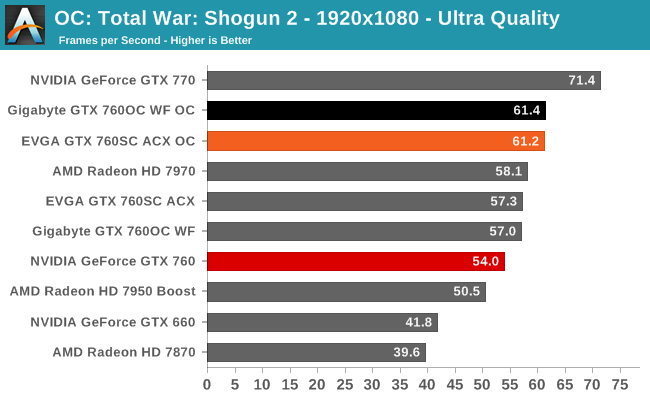
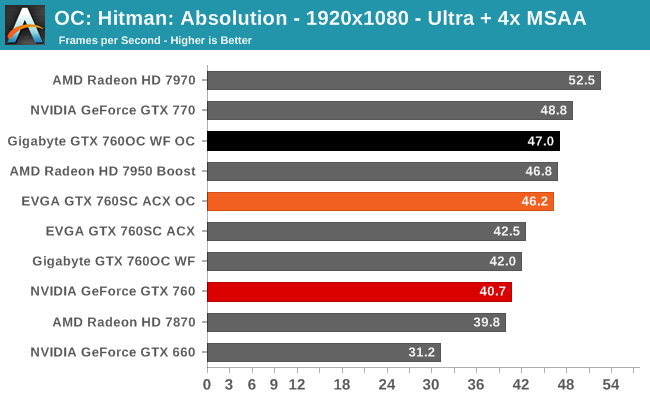
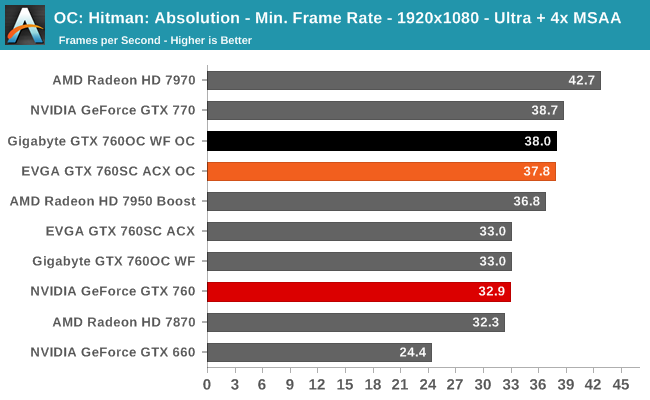
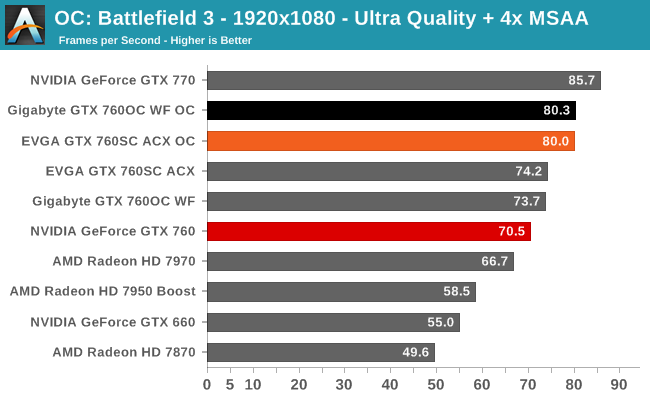
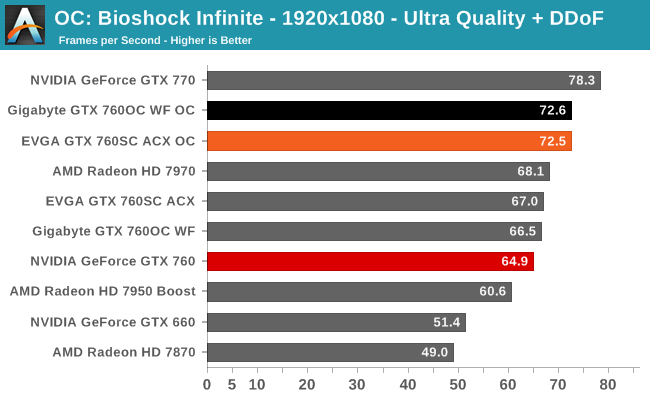
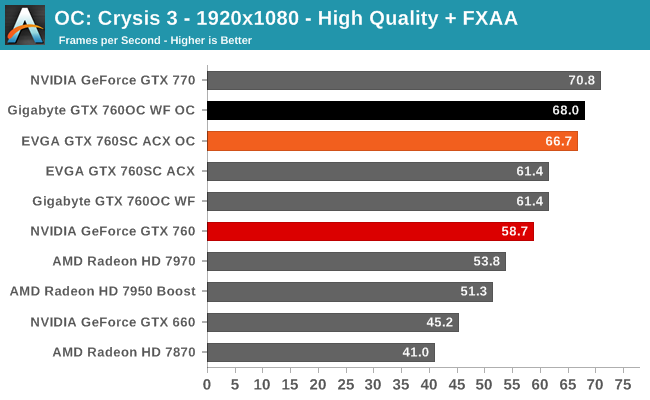
Ultimately the performance differences between the two cards when overclocked is under 2%, despite the higher base and memory overclocks on the Gigabyte card. Gigabyte is consistently in the lead here, even if by just 1/10th of a frame per second, but it’s barely over what experimental variation would give us. Looking at the two cards there’s no reason not to take 2% more performance, but it’s not going to make much of a difference.
With that said, both cards do well for themselves here on an absolute basis due to the combination of their GPU and memory overclocks. The end result of all over this overclocking is 9%-11% improved performance versus their out of the box performance, and upwards of 15% over a stock clocked GTX 760. These are very solid performance improvements, so we’ll have to see what the power and acoustic costs will be.
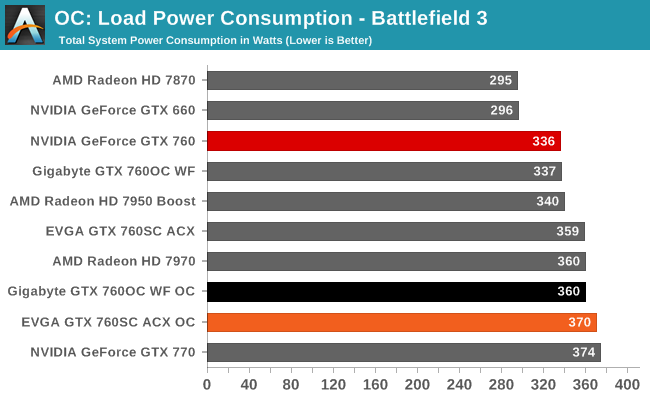
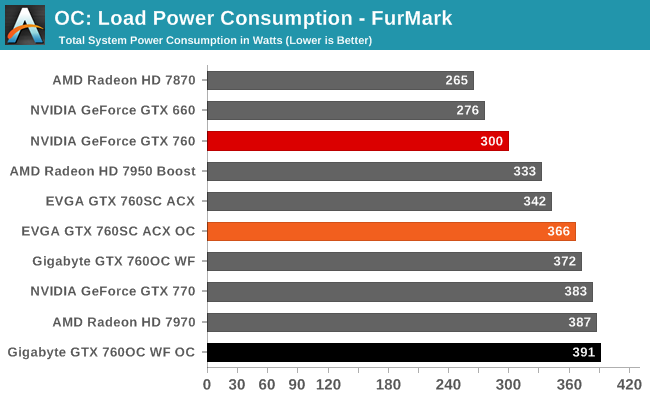
Moving on to evaluating the power, temperature, and acoustic costs of overclocking, as we can see the power costs of overclocking are low-to-moderate. For the Gigabyte card the difference is 23W at the wall under BF3, and a smaller 19W under FurMark. Considering we can’t access the overvoltage boost bin on this card this is a fairly reasonable increase in power consumption, though as with overclocking the reference GTX 760 we are pushing the card off of its ideal performance/power regardless.
Meanwhile for the EVGA card the power cost is just 11W under BF3, and 24W under FurMark. The latter is due to the larger power target increase the EVGA card allows (15% versus 10%) while the BF3 power increase is actually lower that what we’d expect; the reference GTX 760 with similar voltages and power target options saw an almost 40W increase here. This outcome actually equalizes the EVGA and Gigabyte cards a bit under BF3, though with both cards we’re now approaching the power consumption of the stock GTX 770.
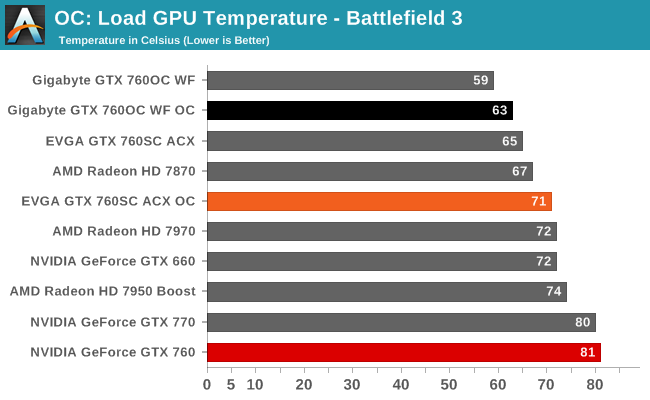
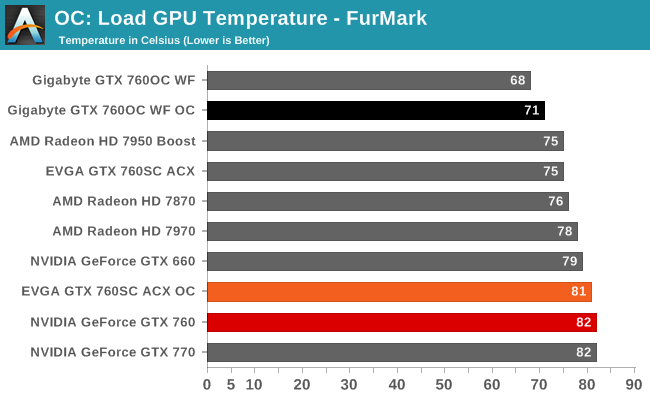
Overclocking has the usual impact on load temperatures, sending them higher in call cases. The EVGA card gets the worst of it, with temperatures rising by 6C under both test cases. The Gigabyte card fares better in that respect, with temperatures rising by just 3C. The end result is that the gap between the cards only grows, with Gigabyte’s card hitting the 60s under gaming and the 70s under FurMark, while EVGA’s card hits the 70s under gaming and the 80s under FurMark. Though it bears repeating that 81C in this case is not the temperature throttle’s work since all of the throttles, temperature included, are raised when we’re overclocking.
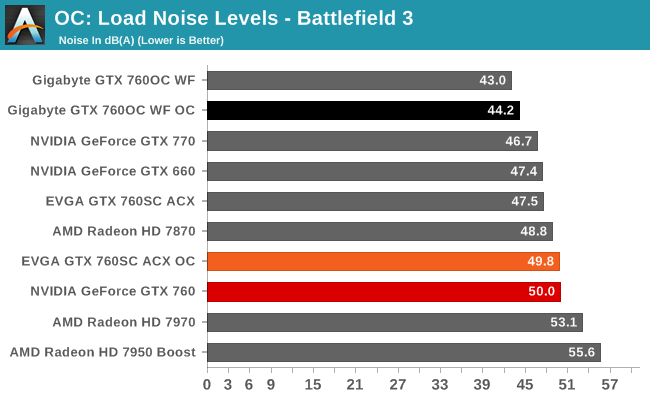
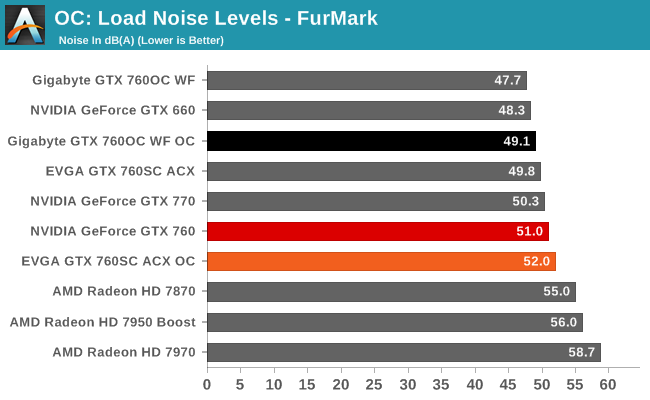
Finally we have the matter of noise, which as is usually the case is going hand-in-hand with temperature. Once more Gigabyte’s card fares the best here, with noise rising a hair over 1dB under both BF3 and FurMark, topping out at 44.2dB and 49.1dB respectively. 44.2dB under a gaming workload isn’t going to be silent, but it’s not too far off of it.
EVGA’s card on the other hand is approaching and exceeding 50dB, with BF3 topping out at 49.8dB while FurMark tops out at 52dB. Like the noise levels under stock, these levels aren’t too far off the mark for an open air cooler when overclocking, but in this case they’re simply not going to be very impressive standing next to the Gigabyte card.
Ultimately overclocking is solidly in Gigabyte’s favor due to cooling considerations. The gaming performance from overclocking their card is not significantly different from the EVGA card and other GTX 760’s we’ve overclocked – which is fairly consistent for GeForce 700 series cards – but what seals the deal for Gigabyte is the fact that even with this overclock they’re still under 45dB for load noise in our gaming workload. Coupled with the lower temperatures and slightly lower power consumption under our gaming workload, and it’s clear Gigabyte is the strongest contender among our GTX 760 cards.
Final Words
Wrapping up this roundup, if GK104 is NVIDIA’s workhorse GPU for this generation, then it’s GTX 760 that is the company’s workhorse video card for enthusiast gamers. It’s well suited for common 1080p monitors, possessing enough power to run most games at near-maximum settings while not reaching ridiculous prices or power consumption levels. It’s for that reason of course that NVIDIA’s partners put out so many variations on the product, as while it’s not necessarily a product line that earns a lot of prestige it’s a product line that’s the bread and butter of their enthusiast offerings.
For that cards we’ve looked at today, Gigabyte’s GTX 770 OC Windforce 3X and EVGA’s GTX 760 Superclocked ACX, we’ve seen both companies take their shot at carving out part of that GTX 760 market for themselves. Though they’re basing their cards on similar design principles – custom boards with open air coolers – as it turns out these cards ended up being more dissimilar than we would have expected based on specifications alone. In this case however that’s less “separate but equal” and more of a one-sided victory for a single party.
As far as gaming performance is concerned the cards are effectively tied, thanks to their near identical factory overclocks. Despite the magnitude of the overclocks however it’s hard to argue that they amount to much in this case; without an equivalent memory bandwidth bump the performance just doesn’t materialize. Granted, 4% better performance is something we’ll gladly take any day of the week, it’s just going to be difficult to justify spending anything extra for it given the limited benefits.
Turning to cooling performance however we have found that Gigabyte’s GTX 760OC is consistently outperforming EVGA’s 760SC ACX on power consumption, temperatures, and noise. It draws less power, operates at a lower temperature, and achieves such effective cooling with less noise generated in the process. By slapping on their full size Windforce 3X cooler Gigabyte has essentially overbuilt their GTX 760OC, but there’s no arguing with the effectiveness of the result. The only drawback here will be Gigabyte’s $10 premium in a crowded market.
EVGA for their part puts up a good fight here, but their 760SC ACX just doesn’t have what it takes to keep up with Gigabyte’s cooling performance. With that said the 760SC still puts in a solid performance for an open air cooler, and it does so in a more compact 9.5 inch size that will no doubt prove useful for smaller cases. EVGA for their part is currently only charging $249 for the card, at-MSRP for the GTX 760 despite the factory overclock, which in this case is likely the right move given the stiff competition.
Hardware aside, on the software and support side EVGA will still have the edge. Gigabyte’s OC Guru II software and 3 year warranty are perfectly adequate, but they will fall short of EVGA’s excellent Precision X software and the options EVGA makes available for extended warranties and stepping up to other EVGA cards. Consequently a choice between the two will ultimately come down to Gigabyte’s acoustic advantage, or EVGA’s slightly lower price and value added features.

